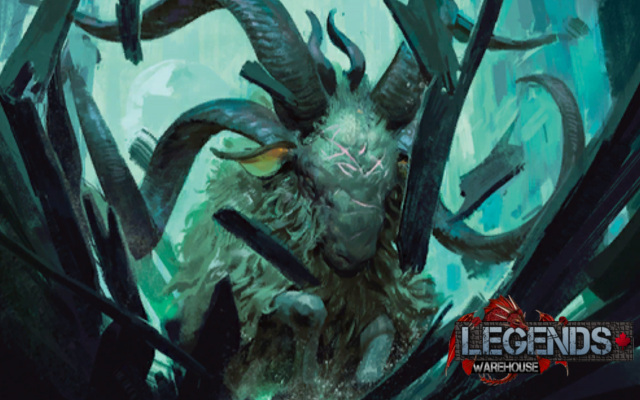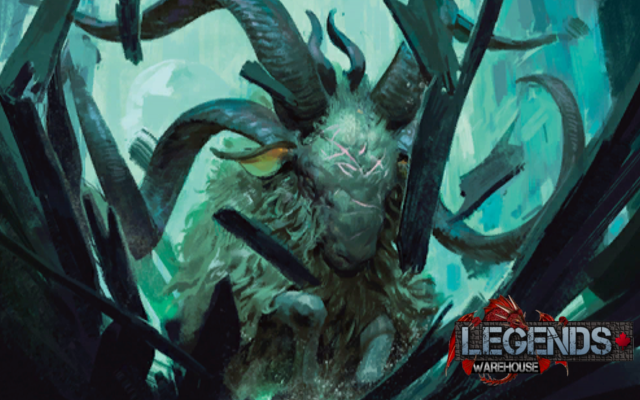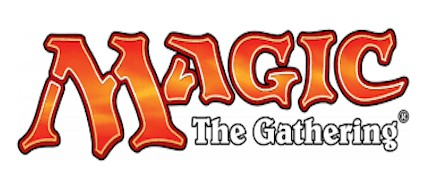A Gateway to Standard
- Legends Warehouse News
- 08 Feb, 2019
Standard doesn’t have to be expensive. In a format with shocklands and Teferi, Hero of Dominaria and the newly minted Hydroid Krasis, it’s important to be able to find ways to play without breaking the bank. Historically, the trick has been to sleeve up as many Mountains and burn spells as possible and go to town, but given the prevalence of Sultai midrange and Wildgrowth Walker, that isn’t even that powerful an option these days. But what if I told you there was a competitive deck in Standard that could be built for roughly the same amount of money as a single copy of Teferi?
Gate Control is one of the most dark horse Magic decks I’ve seen in some time, turning a land subtype often associated with budget Commander decks into an absolute powerhouse when left unchecked. Guilds of Ravnica started the deck on the right path with some interesting Gate-centric spells that hinted at the possibility of a fun Limited archetype, such as Circuitous Route and Guild Summit, but with the inclusion of Ravnica Allegiance the Gates archetype received some pretty impressive cards that pushed it into Constructed territory. First and foremost was the introduction of Simic Guildgate. It seems silly to say, but having a gate capable of casting both of the “Gates matter” from the previous set goes a long way to making sure the deck runs smoothly. In fact, the Simic guild gives this deck a workhorse of a ramp spell in Growth Spiral. This Explore variant gives the deck an instant-speed way of putting additional lands into play as well as cantripping which is exactly what the deck needs to offset the disadvantage of the majority of its lands entering the battlefield tapped.
Ravnica Allegiance also gave the Gates deck three threats that can dominate most board states for very little mana. Gate Colossus, in a similar vein to predecessors like Metalwork Colossus and Mycosynth Golem, is a gigantic artifact creature that you can reduce the cost of by playing more gates. By hitting your mana curve, you can routinely play Colossus as early as turn 5, and even earlier with Growth Spiral. An 8/8 hitting the table that early is terrifying for a lot of decks, and being able to take on something like Carnage Tyrant head to head is something not a lot of threats can boast these days. Furthermore, Gate Colossus has an evasive ability that allows it to bypass walls and other chump blockers which often makes it a three turn clock on its own. Lastly, should your opponent have a kill spell or a Ravenous Chupacabra, Gate Colossus can put itself back on top of your deck from your graveyard whenever a gate enters under your control so, barring a Vraska’s Contempt, your giant threat is going to be impossible to deal with for a lot of matchups.
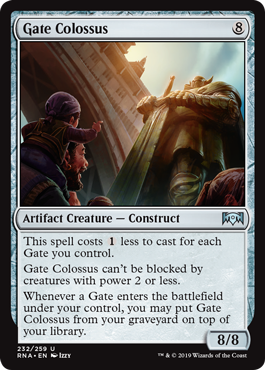

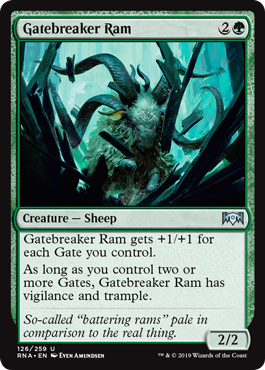
Gatebreaker Ram is probably the most deceptively powerful creature they could have printed for the archetype. Consistently hitting the table as at least a 5/5 for three mana, Gatebreaker Ram has both vigilance and trample should you have two or more gates. Breaking it down as a whole, you’re looking at a 5/5 vigilance, trample body for 2G with room to get even bigger. At. Uncommon. With the way Gatebreaker Ram is worded, it even scales in power to always survive Gates Ablaze, easily the strongest Red sweeper in Standard, since no matter how much damage Gates Ablaze deals, the Ram will always have two additional toughness. This little synergy was an innocuous design choice for Limited that happened to turn downright silly in Constructed. It doesn’t take much effort for the Ram to get utterly disgusting, and like the Colossus, it takes some serious effort to take it down.
The last creature Gates received is the nail in the coffin for all the aggro decks people dreaded would plague Standard after the new set released. Archway Angel is basically Congregate for your lands stapled onto a 3/4 flier, and there is nothing about that sentence that isn’t amazing against aggro. Archway Angel comes down on the turns where you’re looking to stabilize against aggro decks. The turns where they’ve spent so many resources to dwindle your life total down to single digits and they’re just looking for finish you off. You saved a little life from Plaza of Harmony, but it’s not much. Then the Angel comes down and you’re suddenly at a comfortable 15 life and they have no cards in hand. That’s how Archway Angel plays. It makes a dynamic entry that swoops in and saves the day. The deck runs two copies in the maindeck to stave off aggro game 1 and the rest of the set in the sideboard to really hammer home the fact that a burn deck isn’t going to win.
It’s worth mentioning that Guild Summit is probably the most powerful “Gates 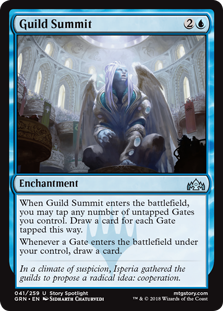 matter” card in the deck. This card is single-handedly capable of saving you in long games when you’re flooding out by turning your land drops into card draw. Imagine having a Nissa, Vital Force emblem in play as early as turn 3 and realize just how many cards you can draw. As well, the second ability of Guild Summit can turn into a ton of cards when topdecked in the late game since you can simply tap a bunch of gates right away to dig for threats. It’s not unheard of for a single copy to net you eight or more extra cards over the course of a game, and when you have multiple in play it’s often difficult to avoid decking yourself from drawing so much. There’s also a brutal synergy with Gate Colossus because, when Colossus is in your graveyard, you can play a gate and stack each trigger so you put the Colossus on top of your deck and draw it right away. This makes grinding out midrange matchups like Sultai into a cakewalk, and it’s one of the easiest ways to putting those types of games away.
matter” card in the deck. This card is single-handedly capable of saving you in long games when you’re flooding out by turning your land drops into card draw. Imagine having a Nissa, Vital Force emblem in play as early as turn 3 and realize just how many cards you can draw. As well, the second ability of Guild Summit can turn into a ton of cards when topdecked in the late game since you can simply tap a bunch of gates right away to dig for threats. It’s not unheard of for a single copy to net you eight or more extra cards over the course of a game, and when you have multiple in play it’s often difficult to avoid decking yourself from drawing so much. There’s also a brutal synergy with Gate Colossus because, when Colossus is in your graveyard, you can play a gate and stack each trigger so you put the Colossus on top of your deck and draw it right away. This makes grinding out midrange matchups like Sultai into a cakewalk, and it’s one of the easiest ways to putting those types of games away.
The sideboard is fairly open to interpretation depending on what your local metagame looks like, but there are definitely some mainstays. Additional copies of Archway Angel are backbreaking against aggro decks and go a long way to making even the fastest mono-Red starts look silly. Negate and Cindervines are often included to stave off the various control and Nexus of Fate decks and punish spell-heavy draws. The rest is often for tech slots, and I’ve seen everything from The Immortal Sun to Mass Manipulation to Crushing Canopy, but by virtue of playing four colours you’re never really at a loss for options.
Naturally, as this is a budget version of a newer archetype, certain cards are going to be omitted due to their price, but if you have access to them, by all means play them. Hydroid Krasis is arguably the defining creature of the current Standard. The sheer card advantage this brings to the table is staggering by acting as both a smaller Sphinx’s Revelation and a gigantic, evasive beatstick. What sets Hydroid Krasis in this deck apart from other shells is that the amount of ramp in this list enables some truly massive Krasis at a much faster rate. An early Growth Spiral or Circuitous Route can often mean the difference between netting a couple cards and refilling your hand in addition to having a much larger body in play than an opposing Krasis.
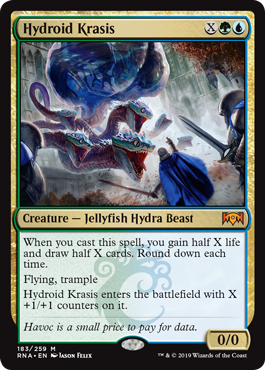

Another non-budget option that the Gates deck can run is Nexus of Fate. This controversial card is all the rage right now and for good reason. When combined with Wilderness Reclamation it represents the possibility of taking infinite turns, which is never something to be ignored. While most Nexus of Fate decks center around using Teferi, Hero of Dominaria’s emblem as a win condition, here it’s a bit more straightforward. Given the size of our threats, all it usually takes is an extra turn or two to deal lethal damage with a Gate Colossus or Gatebreaker Ram. As such, a Nexus of Fate/Wilderness Reclamation shell could also be far less all-in on that aspect compared to other Nexus decks. The inclusion of Wilderness Reclamation is also hilarious with Expansion//Explosion because we can float mana in response to the Reclamation trigger and fire off a huge Explosion in our own end step. It’s not always going to win the game on the spot, but it’s a pretty awesome feeling to pull off and that’s something I can always get behind.
Gates is hands down the most interesting development in the current Standard. It’s the perfect example of a Limited archetype expanding itself into Constructed territory and actually thriving, and as long as Sultai and Esper midrange are top tier decks, it will continue to do so. The combination of giant creatures and lifegain, card draw, and sweepers that scale with your land drops makes it a killer against aggro and midrange. While game 1 against control can be difficult if they find Teferi, the sideboard is set up to clear out the dead cards and completely transform into a control killer. I’ve been amazed by how much fun this deck is, and I look forward to seeing how it will continue to evolve as the Standard season progresses, so if you’re looking for a budget-friendly way to get into Standard, I wholeheartedly recommend putting up some Gates.

